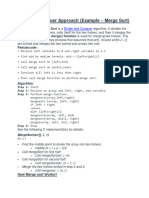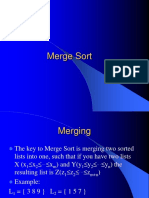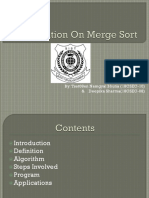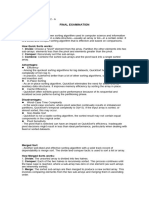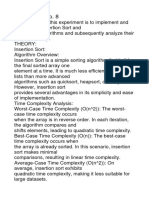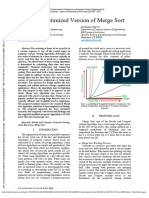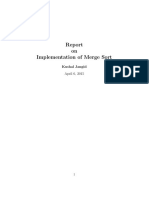Merge Sort: Detailed Explanation
Overview
Merge Sort is a classic divide-and-conquer algorithm used for sorting an array or list. It
recursively divides the input array into two halves until each sub-array has only one element, and
then merges these sub-arrays back together in a sorted manner.
Key Concepts
1 Divide-and-Conquer:
◦ Divide: Split the array into two halves.
◦ Conquer: Recursively sort each half.
◦ Combine: Merge the two sorted halves to produce the final sorted array.
2 Stable Sorting:
◦ Merge Sort preserves the relative order of equal elements, making it a stable sort.
3 Time Complexity:
◦ Merge Sort has a consistent time complexity of O ( n log n ) O(nlogn) for all
cases (best, average, and worst).
4 Space Complexity:
◦ It requires additional space proportional to the size of the input array, with O ( n )
O(n) auxiliary space.
Steps in Merge Sort
1 Divide:
◦ If the array has more than one element, split it into two sub-arrays: the left half and the
right half.
◦ This division is continued recursively until each sub-array contains a single element.
2 Conquer:
◦ Recursively sort the left and right halves. Since an array with one element is already
sorted, this step naturally completes once the division step reaches individual
elements.
3 Combine:
◦ Merge the sorted sub-arrays.
◦ The merging process involves comparing the smallest elements of the two sub-arrays
and repeatedly adding the smaller element to the result array.
Detailed Merging Process
• Initialization:
�◦ Use two pointers to track positions in the left and right sub-arrays.
• Comparison:
◦ Compare the elements pointed to by these pointers.
◦ Append the smaller element to the result array.
◦ Move the pointer forward in the sub-array from which the element was taken.
• Completion:
◦ When one sub-array is exhausted, append the remaining elements of the other sub-
array to the result array.
Example of Merge Sort
Given an array: [38, 27, 43, 3, 9, 82, 10]
1 Divide:
◦ Split into [38, 27, 43, 3] and [9, 82, 10]
◦ Further split to [38, 27], [43, 3], [9, 82], [10]
◦ Finally split to [38], [27], [43], [3], [9], [82], [10]
2 Conquer:
◦ Single elements are trivially sorted.
3 Combine:
◦ Merge [38] and [27] to get [27, 38]
◦ Merge [43] and [3] to get [3, 43]
◦ Merge [27, 38] and [3, 43] to get [3, 27, 38, 43]
◦ Similarly, merge [9], [82], and [10] to get [9, 10, 82]
◦ Finally, merge [3, 27, 38, 43] and [9, 10, 82] to get [3, 9, 10,
27, 38, 43, 82]
Differentiation: Merge Sort vs. Heap Sort
1. Algorithm Type
• Merge Sort: Divide-and-conquer algorithm.
• Heap Sort: Comparison-based algorithm using a binary heap.
2. Stability
• Merge Sort: Stable sort; maintains relative order of equal elements.
• Heap Sort: Not stable; equal elements may not retain their original order.
3. Time Complexity
• Merge Sort: Consistent O ( n log n ) O(nlogn) for best, average, and worst cases.
• Heap Sort: O ( n log n ) O(nlogn) for best and average cases, and worst case O ( n
log n ) O(nlogn).
�4. Space Complexity
• Merge Sort: Requires additional O ( n ) O(n) space for merging.
• Heap Sort: In-place sorting with O ( 1 ) O(1) auxiliary space.
5. Recursion
• Merge Sort: Uses recursion to divide the array.
• Heap Sort: Iterative approach, primarily focusing on heap operations.
6. Performance on Linked Lists
• Merge Sort: Well-suited for linked lists as merging can be done in-place with O ( 1 )
O(1) space.
• Heap Sort: Not suitable for linked lists; operations are efficient on arrays.
7. Use Cases
• Merge Sort: Preferred when stable sort is required or for sorting linked lists.
• Heap Sort: Used when in-place sorting is necessary and additional space is a constraint.
8. Merging vs. Heapifying
• Merge Sort: Merging is the primary operation, combining sorted subarrays.
• Heap Sort: Heapifying is the primary operation, maintaining the heap structure.
Summary
• Merge Sort is efficient for stable sorting, especially with linked lists or when predictable
performance is required.
• Heap Sort is useful for memory-constrained environments requiring in-place sorting but may
not be stable.
Both sorting algorithms have their strengths and are suited for different scenarios, providing
flexibility and efficiency depending on the application requirements.








